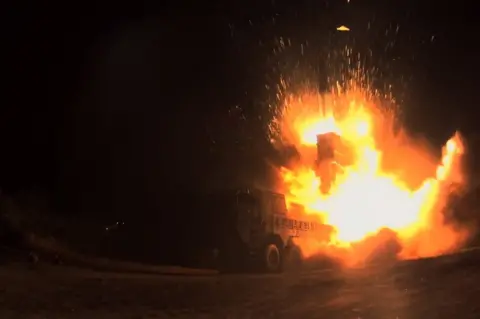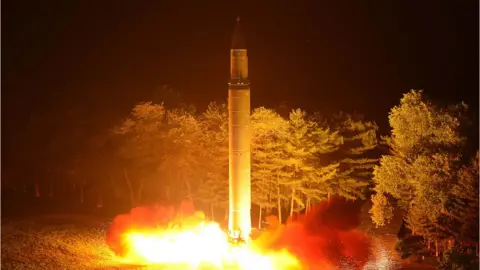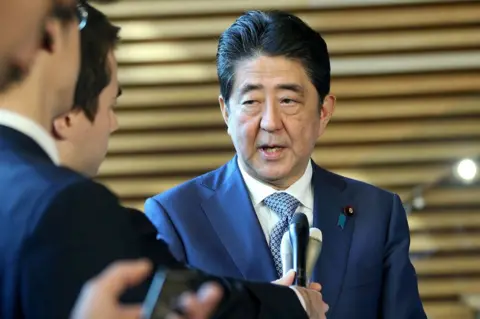North Korea says new missile can re-enter atmosphere
North Korea has said the missile it tested overnight held a warhead capable of re-entering the earth's atmosphere.
The claim was not proven and experts have cast doubt on the country's ability to master such technology.
Kim Jong-un called the launch "impeccable" and a "breakthrough". It was the first test from Pyongyang in more than two months, after a flurry earlier this year.
It has been condemned by the international community.
US President Donald Trump spoke to China's President Xi Jinping by telephone, the White House said, urging him to "use all available levers to convince North Korea to end its provocations and return to the path of denuclearisation".
Allow X content?
Mr Xi responded by telling Mr Trump it was Beijing's "unswerving goal to maintain peace and stability in north-east Asia and denuclearise the Korean peninsula," Chinese news agency Xinhua reported.
China is North Korea's biggest ally and most important trading partner, and the two share a land border.
Experts say the height reached by the inter-continental ballistic missile (ICBM) indicates Washington could be within range, although North Korea is yet to prove it has reached its aim of miniaturising a nuclear warhead.
White House spokeswoman Sarah Sanders said the US would put more sanctions on North Korea "very shortly".
What happened?
The Hwasong-15 missile, described as North Korea's "most powerful", was launched in darkness early on Wednesday.
It landed in Japanese waters but flew higher than any other missile the North had previously tested.
The test, which defied international sanctions imposed over the North's weapons programme, drew swift international condemnation.
South Korea responded by launching one of its own ballistic missiles in a live-fire drill.
 EPA
EPAWhere did the missile go?
Pyongyang says the missile reached an altitude of 4,475km (2,780 miles) and flew 950km in 53 minutes. That huge altitude, sending it far outside Earth's atmosphere, is close to independent estimates made by South Korea's military.
Allow X content?
The projectile, fired at a steep incline, did not fly over Japan as some have done in the past, and landed about 250km short of its northern coast, according to Japanese officials.

What do we know about the new missile?
North Korea has previously said that its projectiles can hit the US but this marks the first time it says it can do it with this new type of missile, which appears to be an upgraded version of previous models.
North Korea says this ICBM is its most powerful yet and completes the country's "rocket weaponry system development set".
 AFP/ Getty Images
AFP/ Getty ImagesSuch a development would make the North's missiles a harder target to hit in a pre-emptive attack by the US.
How far is this new missile likely to be able to go?
An analysis by the US-based Union of Concerned Scientists concludes that the Hwasong-15 could have travelled more than 13,000km on a standard trajectory, thus reaching "any part of the continental United States".
But it seems likely, the analysis adds, that the missile had a very light mock warhead, meaning it might lack the power to carry a nuclear payload, which is much heavier, over that distance.


How have other countries reacted?
- Japanese Prime Minister Shinzo Abe called the launch an intolerable, violent act
- The Kremlin described the test as a "provocation"
- The UK's Foreign and Commonwealth Office summoned the North Korea ambassador to a meeting to "make clear to him our condemnation" and "urge the regime to abandon its illegal pursuit of nuclear and ballistic missiles and return to dialogue".
- South Korean President Moon Jae-in accused the North of "reckless" behaviour but added that there was no choice but to keep applying sanctions
- US defence secretary James Mattis said the missile launch had gone "higher, frankly, than any previous shots they have taken", and said North Korea posed a worldwide threat.
- UN Secretary General Antonio Guterres said the launch had violated sanctions and shown "complete disregard for the united view of the international community"
 AFP
AFPChina urges neighbour against "tensions"
Analysis by Kerry Allen, China specialist, BBC Monitoring
China has officially condemned North Korea's latest missile launch, with foreign ministry Geng Shuang saying: "We strongly urge the DPRK against actions that exacerbate tensions along the peninsula."
State media are strongly signalling that the latest launch is owing to increased frictions caused by the militancy of the US and Japan.
Official broadcaster CCTV and leading foreign affairs paper Global Times highlighted Japanese Prime Minister Shinzo Abe's comment in a press conference today that Japan "will never yield to any provocation" and "will exert maximum pressure".

What sanctions are there on North Korea?
The United Nations first imposed sanctions in 2006 after North Korea conducted its first nuclear test, aiming to stop future nuclear tests and launching ballistic missiles. Sanctions, which were ramped up in 2016, now include:
- An arms embargo
- An asset freeze of North Koreans involved in the weapons programme
- A ban on the export of coal, textiles and seafood
- Restriction on supplies of crude oil
- A cap on countries hosting North Korean labourers
The EU has introduced its own sanctions targeting people and entities tied to the North Korean weapons programme. President Trump added to existing US measures by cutting off the American financial system from foreign businesses doing trade with North Korea. The wave of UN sanctions in August amounted to $1bn (£746m) worth of income, cutting off one third of export revenues, says the US state department.
But so far, sanctions have not stopped North Korea from doing more nuclear and missile tests. A UN Security Council report earlier this year noted that North Korea uses a range of sophisticated techniques, including cloaking foreign financial transactions, to avoid enforcement.
